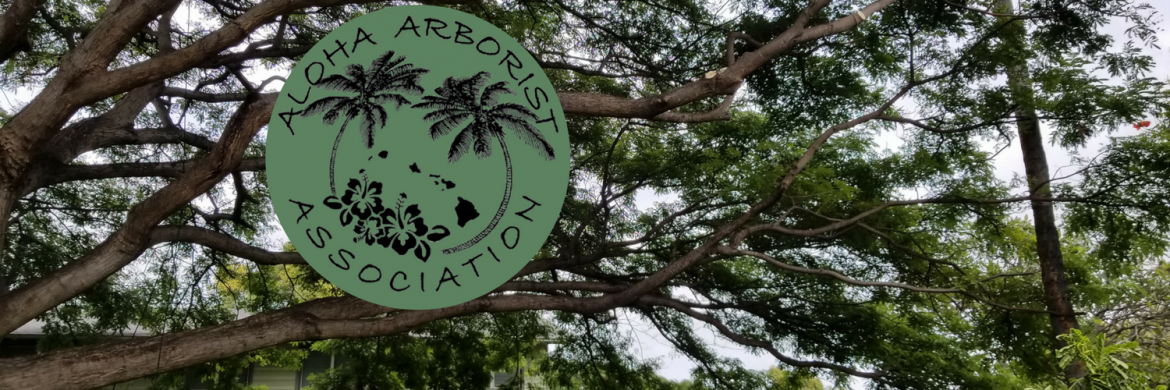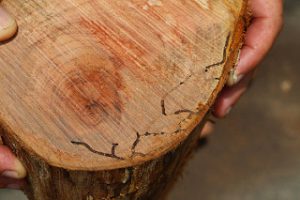AMBROSIA BEETLES
(Weevil Family Curculionidae, SubFamily Scolytinae)
Photos (Except as noted): J.A. Zarders, A.H.Hara, R.Y. Niino‐DuPonte, S.K.Cabral, and K.L.Aoki. Ambrosia Beetles (2013). University of Hawai’I at Mānoa, CTAHR, Komohana Research & Extension Center, Hilo, HI.
Ambrosia beetles are small reddish-brown to dark-brown cylindrical beetles that tunnel into xylem tissue (sapwood or heartwood) and inoculate their galleries with fungal symbionts, on which their larvae feed. (In contrast, bark and twig beetles, many of which are also Scolytid beetles, attack the phloem and/or cambium – generally speaking since there are exceptions.)
Distributi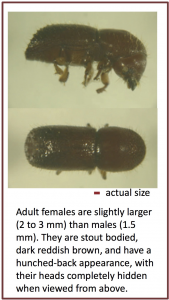 on: Ambrosia beetles are found worldwide. The following are found in Hawaii, along with other native and non-native species: island pinhole borer (Xyleborus perforans), sugarcane shot-hole borer (X. affinis), and ambrosia beetle (X. ferrugineus).
on: Ambrosia beetles are found worldwide. The following are found in Hawaii, along with other native and non-native species: island pinhole borer (Xyleborus perforans), sugarcane shot-hole borer (X. affinis), and ambrosia beetle (X. ferrugineus).
Hosts: Most ambrosia beetles will infest numerous tree species (as opposed to bark beetles, which tend to have a fairly limited host range) – see Reference 1. Most ambrosia beetle species attack stressed plants, but others are known for attacking healthy trees. X. affinis is a vector for laurel wilt, but the fungal agent Raffaela lauricola hasn’t been found in Hawaii yet.
The beetle attacking ohi’a trees on the Big Island may be X. ferrugineus. Researchers are not yet sure whether the beetles are attacking healthy trees, but believe that the beetles – and their wind-blown frass – are contributing to the spread of Ceratocystis.
X. ferrugineus galleries in sapwood of ohi’a. Note the darkening of galleries due to mycelial growth of Ceratocystis fungus. Photo by JB Friday. https://www.flickr.com/photos/jbfriday/35565453983/
Symptoms and Damage: Sawdust tubes may be extruded from entry points; plugged pinholes with staining on the surface of the bark also are commonly seen. Ambrosia beetles typically tunnel into wood, but some (X. affinis) build galleries beneath the bark.
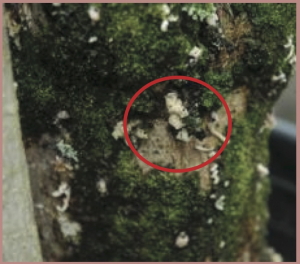
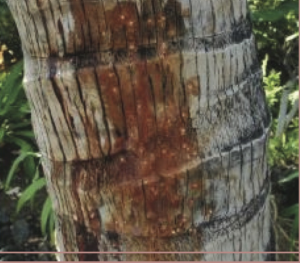
Control
: Once beetles bore into trunks or stems, there are no effective treatments. Preventive measures include maintaining optimal plant health, removing and destroying or properly discarding infested plant material, or applying pesticides before beetles attack.
Reference:
1. A. Zarders, A.H.Hara, R.Y. Niino‐DuPonte, S.K.Cabral, and K.L.Aoki. Ambrosia Beetles. University of Hawai’i at Manoa, CTAHR, 2013.
2. Swain, Steve, Akif Eskalen, Shannon Lynch and Suzanne Latham, “Scolytid beetles and associated fungal symbionts threaten California hardwoods,” Western Arborist (Spring 2017), pp54-60.
3. Atkinson, Thomas H., “Bark and Ambrosia Beetles of Hawaii.” http://www.barkbeetles.info/regional_chklist_condensed.php (Accessed 09/13/17).
